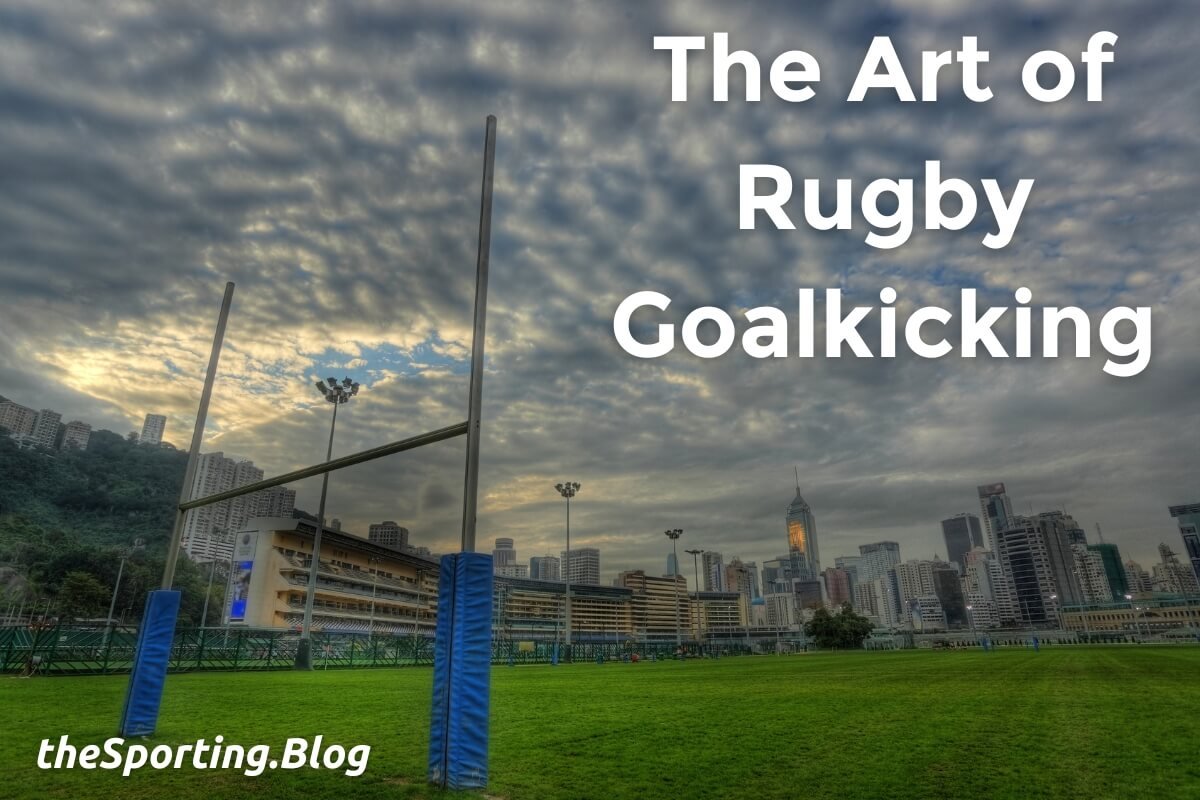The Art of Rugby Goal Kicking
Goal kicking in Rugby: More than just putting your best foot forward
Rugby journalist Daniel Cullinane drills down into the detail regarding goalkicking in Rugby Union, and how detail is a kicker’s best friend.
He looks at the unique pressure goalkickers’ face and puts up 3 of the greatest kickers ever as fine examples of how they overcome it.
More fine Rugby content at the gain line from The Sporting Blog.
The Kicking of a Rugby Ball
The importance of an accomplished goal kicker to a team can’t be underestimated.
In rugby union history, the difference between winning and losing has often come down to the prowess of the player with the kicking tee.
They have the responsibility of keeping the scoreboard ‘ticking over’ and building a score.
When the team are behind on the scoreboard the kicker is a key weapon in closing the gap and clawing back points to get them back into the game.
They have to get the points on offer, sometimes under immense pressure. Just like the sniper on the battlefield, a precision kicker with a good range can punish the opposition, given the opportunity.
During its history, rugby has been blessed with many great goalkickers.
Players who have got the skills both physically and mentally down to a fine art, and deal with the pressure to get the points when it really counts.
This article is about those players. Their practice, their mindset, their routine, and their dedication.
The Greatest Kickers
In this article, I am going to concentrate on three retired world-class kickers.
The top three points scorers in world rugby are Dan Carter of New Zealand, Jonny Wilkinson of England, and Neil Jenkins of Wales. Both Wilkinson and Jenkins became kicking coaches with England and Wales, respectively.
1. Dan Carter (NZ) 1598 International points
2. Jonny Wilkinson (ENG) 1246
3. Neil Jenkins (WAL) 1090
All three players were fly half’s also known as first five-eighths for their countries, and this seems to be the position where most goal kickers play.
It has not always been the case though. Australian second row and captain John Eales was a fine kicker and often took the shots at goal.
Wilkinson and Jenkins also played fly-half for the British and Irish Lions.
In 2005, Wilkinson and Carter faced each other in the Lions tour of New Zealand, where they are more than religious about rugby.
The All Blacks won the test series 3-0. Many regard the second test as Carter’s greatest game where he produced a complete performance as the All-Blacks ran out comfortable winners by 48 points to 18.
Both Carter and Wilkinson’s careers have been blighted by injury, and the time away from the game definitely cost them many more points for their final tally.
Each of these three players were deadly with the boot so it is not a coincidence that they hold the top 3 spots.
Neil Jenkins was a supreme kicking machine for Wales. There was no kicking tee, he relied on a mountain of sand and rarely missed.
He didn’t score many tries for his country, but he kicked the ball between the posts with pinpoint accuracy.
For the Lions in South Africa, he was pivotal to the team’s success on that tour in 1997.
Rugby Goalkicking - How they do it.
To get to the nuts and bolts of how a goal kicker will ply their trade, I turned to Peter Breen of rugbybricks.com.
Peter is a former Otago fly-half and now coaches attack for Australia’s women’s team, the Wallaroos.
He works one-on-one with several internationals as a skills coach and provides online programs through the Rugby Bricks website.
I asked Peter what it takes to become a great kicker and what preparations are needed both physically and mentally.
He told me that the mindset of the kicker is significantly important.
The ability to stay focused or ‘locked-in’ can mean the difference between success or failure from the kicking tee.
Maintaining focus is a very trainable skill and Peter described how important it is to create a pressure environment during training.
Although it’s not possible to fully replicate the atmosphere of matchday in a packed-out stadium, it is possible to take the kicker out of their comfort zone by creating distractions during the session.
It might be a teammate calling them names or rolling something in front of them as they are about to take the kick.
Anything that can knock the kicker’s focus can be used to try and create the sort of pressure they will be under during a match.
Maintaining focus and being able to move from one task to the next during the game, is a challenge for any player.
For a kicker, as fatigue increases, focus and technique suffer. The great kickers understand this and aim to gain control over themselves.
Switching off from the distractions around them, they will seek a calm and focused state.
They will try and slow their racing heartbeat with a couple of deep controlled breaths and then go through their kicking routine as composed as possible.
Peter referred to the 10,000 eyes effect, where the kicker, rather than being overwhelmed by all the spectators and players watching will use the scrutiny as energy to produce a successful result.
The key to a successful kick is an application of skills to a consistently high level, time after time. Peter goes through a routine he has developed called the 10 Pillars.
In this video Rugby Bricks coach Peter Breen talks through how to become a successful goal kicker.
It is a structured way of breaking down the kick into 10 component parts.
The 10 Pillars of Rugby Goalkicking
Mindset
The ball set up
A long target
Approach to the ball
The rodeo arm
The planted foot
The position of the kicking foot
The hips
Momentum
Head Down
There is an additional pillar. When the kick doesn’t go well, Peter describes it as ‘Parking the kick’.
This is the ability to identify what went wrong and then move on.
He described the kicker wiping their boot to mentally wipe that kick away, reset and move on to the next one.
Of course, to become a great kicker, all of the above must be honed over many hours of practice in all conditions.
If the kicker can put in the work and make the kick under extreme pressure, then confidence will grow and will set them up for continued success in the most hostile of environments.
N.B Check out The Sporting Blog Podcast with Peter Breen here!
Examples from the Masters
I have picked some examples where these 3 great kickers have produced world-class execution under pressure.
Dan Carter
Dan Carter tops the points-scoring record and is one of the greatest All-Blacks of all time.
The reason was, not only was he a phenomenal kicker, but he also possessed speed and agility and scored 29 international tries.
But it’s his kicking that the bulk of his points came from. In this example, Carter demonstrates the importance of knowing the conditions.
With a strong crosswind, he keeps the ball low and aims off to curl the ball between the posts.
It’s an incredible piece of skill and a great example to young kickers on how important it is to work out the conditions on match day.
Jonny Wilkinson
Wilkinson was a fierce defender and set new standards for fly half’s around the world when it came to aggressive defence and quality tackle technique.
But its the dropkick that won the 2003 Rugby World Cup for England that will always be the defining moment of Jonny Wilkinson’s playing career.
He didn’t have the speed and agility of Carter but as a goal kicker there was very little between them.
In this clip, Wilkinson goes through his thought process every time he is called upon to kick the points.
He immediately switches to the first pillar, mindset and begins his well-rehearsed kicking routine. The one he has done thousands of times.
Jonny Wilkinson is one of the best kickers ever to play in the RBS 6 Nations - watch footage of his unique routine.
Neil Jenkins
The consistency that Neil Jenkins displayed as a kicker for Wales and the British Lions was outstanding.
Perhaps not regarded as the complete No 10 but absolutely deadly with the boot.
Against France, in 1999 he knocked over 9 penalties, a personal haul of 27 points in the match.
What Jenkins demonstrated in the match was his ability as a world-class kicker to consistently do what is asked of him, no matter how tired he was and kick the points for the team.
Neil Jenkins slots 9 penalties for Wales in one game Vs France in 1999.
A Final Word on Rugby Goal-Kicking Perfection
When we see professional players effortlessly kicking 3 points, it’s easy to forget the hours of practice they have put in over the years to get to that point.
The sacrifice they and others have made in pursuit of perfection. Even Christmas Day didn’t prevent Jonny Wilkinson from getting out on the training pitch for a kicking session.
The time spent out there would depend on how the session had gone. But to be the best, that is the sacrifice that players like him, Carter and Jenkins made for years.
They undoubtedly had talent like any decent goal kicker, but it’s the work ethic that makes the difference between them and the rest. Without that dedication, rugby may have been robbed of some of its most exciting and iconic moments.











